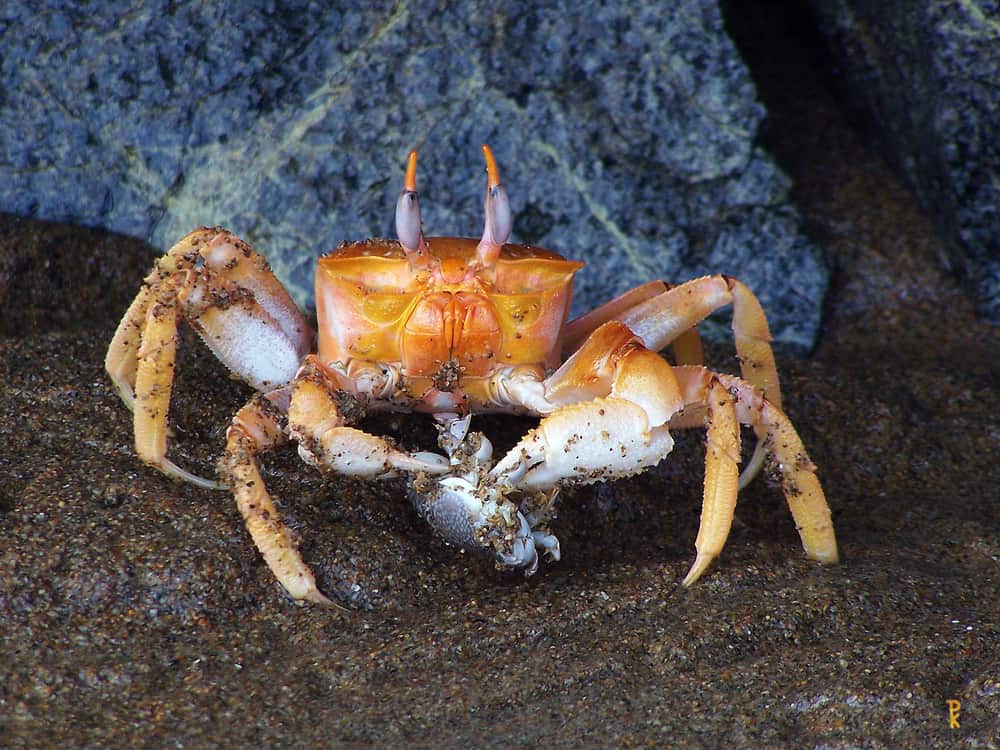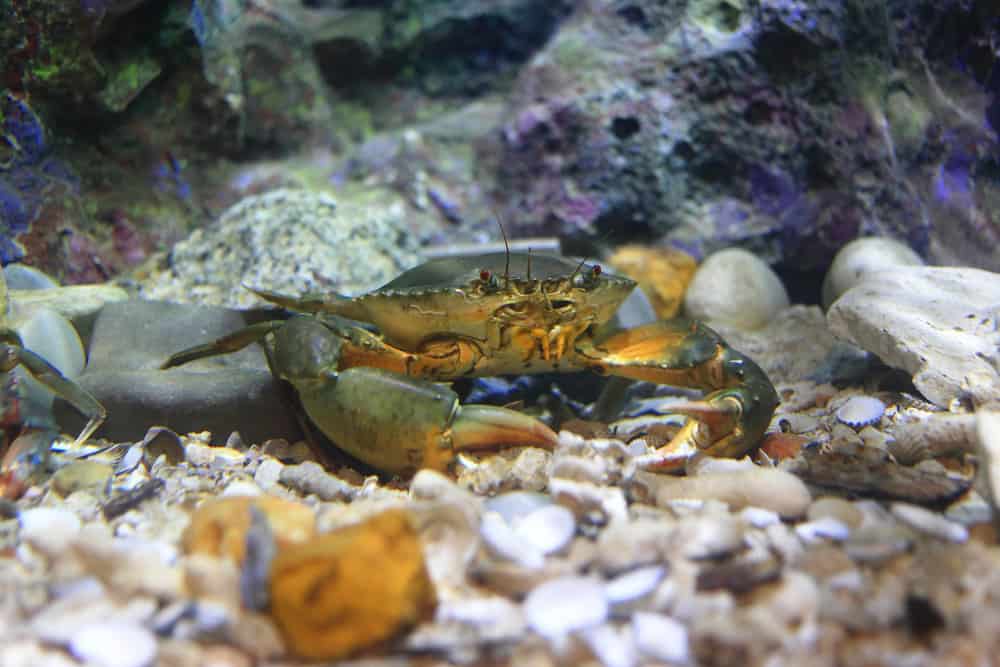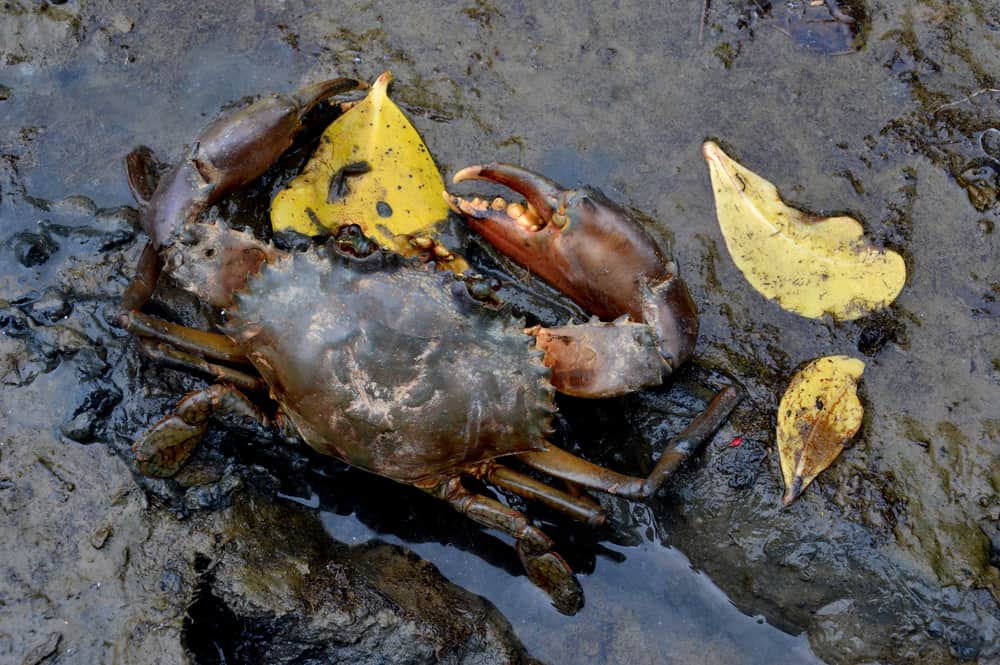You know them for having claws and their peculiar walk. Did you perhaps think all crabs were red? Not true! You can find them on the beach as some love to swim.
But, what do crabs eat after a long day at the beach? Here, you’ll find out.
Crabs Habits And Biology
Crabs are found worldwide in all oceans, fresh and marine water, and also live on land. They have exoskeletons made of chitin.
Crabs have five pairs of legs. Over time the front pair of legs evolved into chelae. Chelae is the claw-like organs found at the end of the limbs of crabs.
The chelae/claws are used for self-defense, courtships and are also used to capture prey. Crabs have modified legs that force them to walk sideways.
Some crab species can swim. Their hind legs resemble swimming paddles that they use to propel themselves in water.
Males species of crabs tend to be aggressive towards one another. They will fight one another for mating rights. They will also fight over living spaces. Fiddler crabs dig holes in mud or sand, used for hiding, mating, or resting.
Crabs are omnivores and primarily feed on algae. They also eat other foods like snails and slugs, among other prey. Whatever is available, they’ll have a piece.
Crabs have chemoreceptors (taste buds) that help them identify chemicals discharged in water by prey. A majority of the receptors are on the creature’s antennae.
Chemoreceptors near the crab’s eyes allow it to view the environment—the ‘receptors’ found on the hairs of its mouthparts that function as food tasters.
Crabs that usually grow the fastest feed on both plant and animal matter. However, some species only eat one type of food. Some only feed on plankton (plant matter).
Although they fight a lot amongst each other, they sometimes work together to find food and protect their families.
Both male and female crabs work together to find the perfect place to lay eggs in the mating season.
As crabs mature, they molt several times. Molting is when the crab sheds its shell as it grows. Crabs can live for three to twelve years, depending on the species and environmental conditions.
Do Crabs Eat Dirt?
Yes. Crabs eat dirt for a variety of reasons depending on the species. The fiddler crab takes in small amounts of sand or mud, depending on the area it inhabits.
Using their specialized mouths, they scrape any food from the dirt, such as algae. Afterwards, it forms either mud or sand pellets and ejects them from its mouth.
Hermit crabs feed on their poop. Being scavengers, they will consume just about anything. The crab will feed on its poop, so it doesn’t lose the vitamins and minerals found in it.
Crabs feed on dirt mainly to obtain minerals such as calcium that help grow a strong exoskeleton.
What Do Crabs Like To Eat Most?
As previously discussed, crabs are omnivores and will feed on both plants and animals. Some species are specialized in their diets and will only stick to one meal.
Food availability and environmental conditions play a role in what these creatures eat. Aquatic crabs will sustain themselves with foods such as:
- Dead animals
- Coral reefs
- Snails, slugs, and earthworms
- Algae
Crabs that spend more time on the land will search for food after sundown. These crabs will eat:
- Fecal matter (poop)
- Food left by human beings on the beach
- Garbage
- Wood
- Moss
- Leaves
Crabs kept in captivity should initially be offered a diet similar to what they consumed in the wild—some species struggle to adapt to life as a pet. The following are among the food items hermits will eat in captivity:
- Fish flakes –hermit crabs kept in the same tanks with fish will help themselves to left-over fish flakes. Good quality fish flakes can be used as a treat for the crabs with time.
- Eggs –are a great source of protein for crabs. They can either be boiled or scrambled.
- Cuttlebone –is the skeleton of cuttlefish. It is high in calcium and therefore nutritious for crabs. It can be ground into powder and sprinkled onto other foods for your pet to enjoy.
- Leafy greens –are packed with calcium and serve as an excellent addition to crab’s diet.
- Oatmeal
- Peanut butter and jam –should be hand-fed to prevent the pet crabs from getting it into their gills that might cause suffocation.
- Eggshells –can be ground up and fed to pet crabs. They act as a good source of calcium for the crabs.
- Meat and fish –when purchasing meat to feed pet crabs, you should ensure that the meat is free of preservatives. Thoroughly cook the meat and allow it to cool before serving your pet crab.
- Seeds, nuts, and grains –are rich in proteins. It would be best if you chopped them into small pieces before being fed to the pet crab.
Foods To Avoid Feed Crabs
Crabs may not be picky eaters, but that doesn’t mean they feast on everything. Depending on the species of crab you plan on keeping as a pet, you should be aware of what is toxic to them.
Let’s have a look at some of the food items toxic to crabs:
- Pesticides and herbicides –artificial chemicals are harmful to crabs. Consider purchasing fresh produce to feed your crabs.
- Moldy foods or rotten foods –feeding hermit crabs rotten foods can cause them to fall sick and eventually die.
- Table salt –contains large quantities of iodine. Ingestion of too much iodine can prove to be poisonous for a hermit crab.
- Onions and garlic
- Citrus fruits –most hermit crabs will show no interest in citrus fruits due to their strong scent.
- Avocado leaves –fruit is edible, but the skin and leaves are harmful to most animal species, including crabs.
- Carnation (flower) leaves –leaves and stems of the carnation are poisonous if ingested.
- Prune species of trees –such as bitter almonds, apricots, peach, and plums. Fruits are edible. Every other part of the plant contains fatally toxic cyanide.
- Chocolate/cocoa –contain a lot of processed sugars and chemicals which can prove toxic to crabs.
- Catnip
- Cinnamon
- Lavender
- Peppermint
- Rosemary
Hermit crabs also require clean water to survive. The best water to offer to your pet crab is spring water purchased from your local store.
Alternatively, use a water purifier to distill tap water from home. Unpurified tap water can lead to the death of hermit crabs.
Chemicals and metals found in tap water cause blisters and scarring of the gills, followed by suffocation. There should be no traces of chlorine in a hermit crabs habitat.
Tips To Feeding Crabs
Having a pet crab can be a real treat. Before buying a crab, there are some factors you need to put into consideration:
Know which species of crab you want to buy. For instance, if it’s a hermit crab, you should know the different types of hermits available for sale.
- The most popular hermit crab kept as a pet is the Caribbean, also called the purple pincher. The purple pincher is the best pet crab to start your journey as a crab owner. They are easier to care for than other animal species.
Ensure to handle your pet crab with care. When you purchase a pet hermit, for example, the crab will take some time to get comfortable in its new environment.
- Leave the crab in its cage for a few days. Once they stop hiding in their shells when you pass by then, you can wait an extra day or two before picking it up.
- Sometimes it takes longer for the crabs to get used to you. During this period, change your crab’s water and food regularly and don’t bother them.
By this time, you should be aware that crabs undergo molting and require extra shells. When you see your crab digging in the soil, don’t be worried.
Give you crab space during this time. Like snakes shed their skins, crabs shed their exoskeletons as they grow. When molting is over, don’t throw the shed exoskeleton away.
Your crab will need to feed on it to harden its new exoskeleton.
- Provide shells for your hermit crab. As they continue to grow, they require larger shells which can be purchased at pet stores or collected from the beach.
- Some crabs prefer shells with rounded openings as opposed to those with oval openings. Refrain from buying painted shells.
- Although companies claim their paints to be safe, they might chip off, and your pet ingests them. It can be poisonous.
Be sure to provide a stable and varied diet for your crab.
- Hermit crabs will eat almost anything as they are scavengers by nature. Please don’t feed them anything with preservatives or anything hot or spicy.
- Feed crabs fresh shrimp, bloodworms, and other seafood.
Follow the above steps to care for and feed crabs better. With time you can get more companions for your crab.
Summary
So, how do crabs get around on land? They use the sidewalk.
Remember, when caring for your pet crabs, don’t feed them anything with preservatives or chemicals. Watching them grow is a delight. When it comes to having a pet crab, patience pays.


